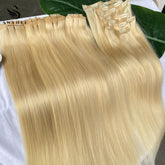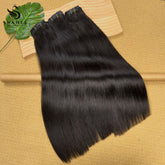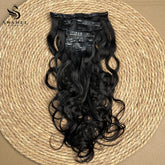Clip-In vs Tape-In Hair Extensions: Which One Should You Choose?
In recent years, the hair extension market has grown by leaps and bounds. From the tried-and-true clip-in methods to modern fusion techniques with keratin bonds, there are numerous options for achieving longer, fuller hair. In this guide, we'll help you decide between two popular choices: clip-in and tape-in extensions. Answering these key questions first will simplify your decision:
Are you looking for something more permanent?
How much time can you dedicate to styling daily?
Do you want to wear extensions every day?
Do you color your hair regularly?
What is your budget for hair extensions?
How Long Do You Want Extensions to Last?
This question addresses both the lifespan of the extensions and their replacement frequency. With proper care, clip-in extensions can last years—a smart investment for occasional wear or specific styles. Maintenance involves gentle washing, minimal handling, and careful combing.
Tape-in extensions, conversely, typically last 3 solid months with continuous wear. They stay in place until hair growth requires removal or reapplication (some brands allow reuse with fresh tape). Since they're washed with your natural hair, frequent shampooing accelerates wear and tear on the extensions.
Styling Time Commitment
Consider your daily styling routine. If you're always rushed, tape-in extensions are ideal—their seamless installation reduces daily effort. Clip-ins, however, require time to hide wefts, depending on your natural hair texture and the product quality. Tape-ins offer discreet styling versatility, often cutting down styling time significantly.
Daily Wear Preference
This comes down to personal comfort. Clip-ins excel in convenience—easy to apply and remove daily, perfect for those who prefer sleeping without extensions. Tape-ins are semi-permanent, staying in place during washing and styling. Note: Frequent washing can weaken their adhesive, so moderation is key. New users are generally advised to start with clip-ins for a low-commitment introduction.
Coloring Compatibility
Frequent hair coloring or root touch-ups require careful consideration. Tape-ins are not recommended for coloring sessions—the harsh chemicals can degrade the adhesive, causing premature slippage and costly salon fixes. Clip-ins, however, can be easily removed before coloring, allowing you to treat your natural hair as usual. Both methods require color consistency—drastic hair color changes will necessitate recoloring the extensions themselves.
Budget Considerations
Cost includes both upfront purchase and long-term maintenance. Clip-ins have a single upfront cost, varying by quality: human hair (especially Remy, the premium grade) is pricy but durable, while synthetic options are cheaper but limited in heat resistance and lifespan. For tape-ins, skipping quality is ill-advised—daily wear makes synthetic hair prone to tangling and rapid deterioration. Invest in high-quality extensions for longevity and natural appearance.
By weighing these factors—longevity, styling effort, wear frequency, coloring needs, and budget—you can confidently choose between clip-in and tape-in extensions that best suit your lifestyle and beauty goals.








